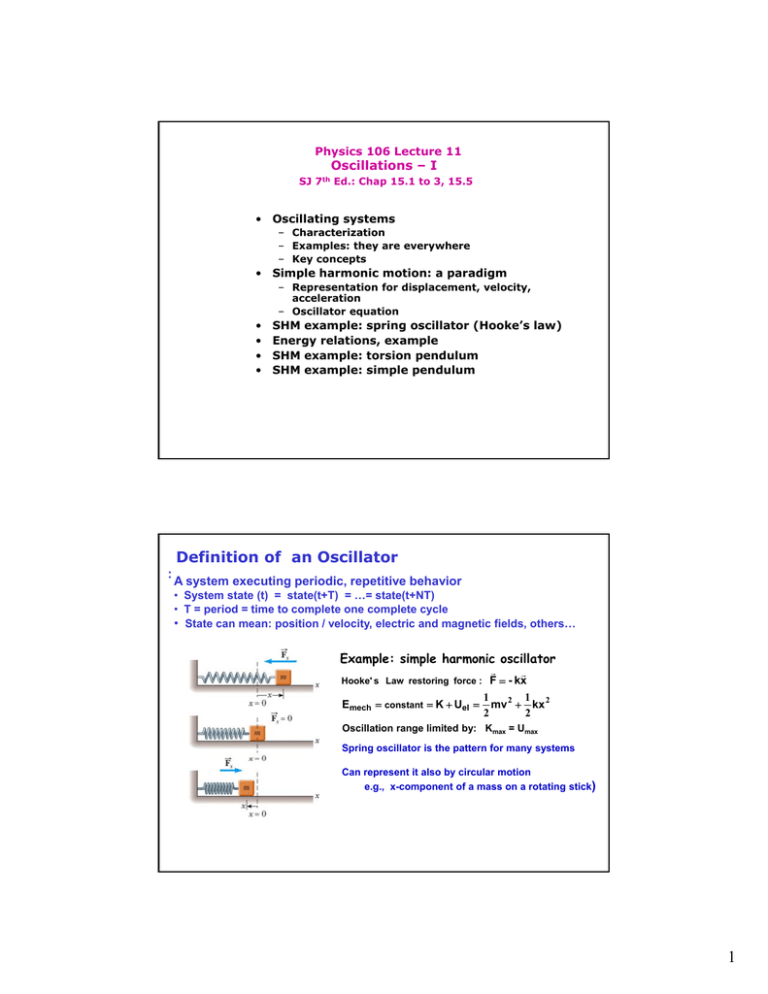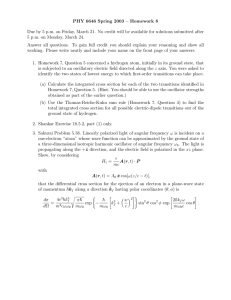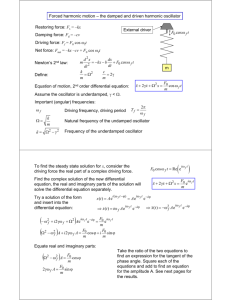Lecture 11
advertisement

Physics 106 Lecture 11 Oscillations – I SJ 7th Ed.: Chap 15.1 to 3, 15.5 • Oscillating systems – Characterization – Examples: they are everywhere – Key concepts • Simple harmonic motion: a paradigm – Representation for displacement, velocity, acceleration – Oscillator equation • • • • SHM example: spring oscillator (Hooke’s law) Energy gy relations, example p SHM example: torsion pendulum SHM example: simple pendulum Definition of an Oscillator : A system executing periodic, repetitive behavior • System state (t) = state(t+T) = …= state(t+NT) • T = period = time to complete one complete cycle • State can mean: position / velocity, electric and magnetic fields, others… Example: simple harmonic oscillator G G Hooke' s Law restoring force : F = - kx Emech = constant = K + Uel = 1 1 mv 2 + kx 2 2 2 Oscillation range limited by: Kmax = Umax Spring oscillator is the pattern for many systems Can represent it also by circular motion e.g., x-component of a mass on a rotating stick) 1 Oscillating systems are everywhere in nature: MECHANICAL: • pendula (swinging objects on cables) • auto suspensions • music/sound (e.g,string instruments) • guitar, piano, drums, bells, horns, reeds… • rotating g machines,, vehicle wheels,, orbits,, structures,, Simple systems spring y pendulum θ(t) x(t) L v(t) a(t) θ m vibrating string ω(t) α(t) y(t) vy(t) ay(t) x(t) m θ x vx(t) ax(t) uniform circular motion Electrical examples: • clocks, radios driven by oscillator circuits • atomic and molecular energy states • light, x-rays, IR, radio, other EM waves • antennas, transmitters • the stable shapes of solid objects Simple Harmonic Oscillators applied to solids • • Simple harmonic oscillators are good models of a wide variety of physical phenomena Molecular example – If the atoms in the molecule do not move too far, the forces between them can be modeled as if there were springs between the atoms – The potential energy acts similar to that of the SHM oscillator simple oscillator realistic potential 2 Water Waves: Harmonic oscillations of the level at a point disturbance y1 (t ) = y10 cos( 2πft ) The phase angle Φ sets the clock v y 2 (t ) = y 20 cos( 2πft + φ) v Some concepts for oscillations restoring force: natural frequency: A force causes the system to return to some equilibrium state periodically and repeat the motion Resonant oscillation period, determined by physics of the system alone. Disturb system to start, then let it go. E Examples: l pendulum d l clock, l k violin i li string ti undamped oscillations: Idealized case, no energy lost, motion persists forever Example: orbit of electrons in atoms and molecules damped oscillations: Oscillation dies away due to loss of energy, converted to heat or another form. Example: a swing eventually stops simple harmon c harmonic oscillation: Undamped natural oscillation with F = - kx (Hooke’s Law); i e restoring force is proportional to the displacement away i.e. from the equilibrium state forced oscillations: External periodic force drives the system motion at it’s own frequency/period, may not be the resonant frequency 3 Characterizing oscillations Amplitude xmax • maximum displacement away from equilibrium (disturbance) displacement Period T • time for motion to repeat time Frequency f = 1/T • # of cycles per time unit • [Frequency] = Hertz (Hz) = t-1 Angular frequency: • ω = 2πf (units: rad/s) • ωT = 2π (radians) • T = 2π / ω “Phase”: where in the cycle the system is “Phase constant” or “phase angle”: pick what part of the cycle is at t = 0 amplitude Amplitude and phase constant specify the initial conditions for an oscillator Frequency and amplitude of an oscillator 11.1. The figures show plots of the amplitude of two harmonic oscillators versus time. When object B is compared to object A, which of the following correctly describe the angular frequency and amplitude? A) B) C) D) E) B has larger frequency and larger amplitude than A B has larger frequency and smaller amplitude than A B has larger period and larger amplitude than A B has smaller frequency and smaller amplitude than A B has larger period and larger amplitude than A ω = 2πf = 2π/T x(t ) = x m cos(ωt + ϕ) 4 Hooke’s Law (Spring)Oscillator F(t ) = − kx(t ) F F Restoring force – use Second Law F(t ) = m a(t) = m Force equation ∴ d2 x(t ) dt 2 = − d2 x(t ) dt 2 k x(t) m = − k x(t) -xm +xm No friction losses Prototype for oscillator equations describes periodic motion with resonant frequency: ω = km Equations of the form above have sine (or cosine) wave solutions: x(t ) = x m cos(ωt + ϕ) Initial condition examples: Angular g frequency q y ω = 2πf = 2π/T If x(t=0) = xm then phase constant φ = 0, +/- 2π, etc If x(t=0) = 0 then phase constant φ = π/2, 3π/2, etc stiff spring / small mass Æ high frequency, short period big mass / weak spring Æ low frequency, long period Example: auto suspension trades off spring stiffness against un-sprung weight Representation of Simple Harmonic Motion… …as the x-component of a vector rotating at constant speed displacement at time t phase angle x(t ) = x m cos(ωt + ϕ) amplitude r = xm= x(t=0) phase constant (radians), equals zero for sketch r ωτ x(t) angular frequency y(t) would be represented as sin(ωt+φ) velocity at time t Note : d(cos[f(t)]) df ( t ) = − sin[ f (t )] dt dt -xm dx(t ) = − ωx m sin(ωt + ϕ) dt sketch shows φ =0 since clock starts maximum v ≡ − ω x m m when p phase angle g =0 velocity v x (t ) ≡ dv x (t ) = − ω 2 x m cos(ωt + ϕ) dt maximum a acceleration m T If φ = π/2, clock starts at ωt = - π/2 acceleration at time t a x (t ) ≡ +xm ≡ − ω2xm d2x(t) ≡ −ω2x(t) dt2 solutions of equations like this oscillate: 5 Motion Equations for Simple Harmonic Motion A = xmax • • • x (t ) = A cos (ωt + φ ) dx v= = −ω A sin(ω t + φ ) dt d 2x a = 2 = −ω 2 A cos(ω t + φ ) dt Simple harmonic motion is one-dimensional - directions can be denoted by + or - sign Simple harmonic motion is not uniformly accelerated motion The sine and cosine functions oscillate between ±1. The maximum values of velocity and acceleration for an object in SHM are: k A m k = ω2A = A m v max = ω A = amax Position and velocity of an oscillator 11.2. The figure shows the displacement of a harmonic oscillator versus time. When the motion has progressed to point A on the graph, which of the following correctly describe the position and velocity? A) B) C) D) E) The position and velocity are both positive The position and velocity are both negative The position is negative, the velocity is zero The position is positive, the velocity is negative The position is negative, the velocity is positive x(t ) = x m cos(( ωt + ϕ) v x (t ) ≡ dx(t ) = − ωx m sin(ωt + ϕ) dt 6 Example: Spring Oscillator in natural, undamped oscillation Let k = 65 N/m, xm = 0.11 m at t = 0, m = 0.68 kg a) Find ω, f, T x(t ) = x m cos( ωt + ϕ) ω = k/m = 65 / 0.68 = 9.78 rad / s f = ω / 2π = 1.56 Hz v x (t ) = − ωx m sin(ωt + ϕ) T = 1/f = 0.64 s = 640 ms a x (t ) = − ω 2 x m cos( ωt + ϕ) b) Find the amplitude of f the oscillations scillati ns x m = 0.11 m c) Find the maximum speed and when it is reached vm = amplitude of v(t) = ωx m = 9.78 × 0.11 = 1.1 m/s at t = T/4, 3T/4, etc d) Find the maximum acceleration and when it is reached am = amplitude of a(t) = ω 2 x m = (9.78) 2 × 0.11 = 11 m/s 2 at t = 0, T/2, same as x(t) e) Find phase constant t = 0 : x(t) = x m = x m cos( ϕ ) ⇒ cos( ϕ ) = 1 ∴ ϕ = 0, + / - 2π, etc Match initial conditions at f) The formula for the motion is: x(t ) = 0.11 × cos(9.78t + 0) Energy applied to simple harmonic oscillators Emech = K + Uel = 2 mv 2x + 2 kx 2 1 F = −kx Recall: 1 constant if no damping or forces other than the spring (Hookes Law restoring force) xf W = ∫ Fdx = - Uel = 0 work done in stretching spring from 0 to x f xf ∴ Uel = (− )(− )k ∫ xdx = 0 1 2 kx f 2 x(t ) = x m cos(ωt + ϕ) v x (t ) = − ωx m sin(ωt + ϕ) Oscillator solutions: ω 2 = k/m v x, max = ωx max where: Energy: 2 Emech = 2 m(− ωx max ) 2 sin2 (ωt + φ) + 2 kx max cos 2 (ωt + φ) 1 1 [ 2 = 2 kx max sin2 (ωt + φ) + cos 2 (ωt + φ) 1 ] this always = 1 Result: 1 1 2 Emech = 2 kx max = 2 mv x2 ,max for no losses (damping) 7 Energy in SHM summary K x(t ) = A cos (ωt + φ ) dx = −ω A sin(ω t + φ ) dt 2 d x a = 2 = −ω 2 A cos(ω t + φ ) dt v= Simple Pendulum U SHM, small amplitude oscillation of angular coordinate • Mass m swinging at the end of a massless string • Angular displacement θ(t) oscillates: • Gravity provides restoring torque: • Apply angular Second Law: τ = Ια = Ι no torque d2θ( t ) dt • Solution oscillates: displacement at t natural frequency ω≡ d2 θ dt 2 (force equation) Ι ≡ mL2 θ3 θ5 sin(θ) = θ − + − ..... ≈ θ 3! 5! mgL ∴ α( t ) ≈ − θ(t ) mL2 • Apply A l small ll θ approximation: torque − θm ≤ θ ≤ + θ m τ = − m g L sin(θ) g L 2 = − g θ(t) L • Another oscillator equation: acceleration and displacement have same time dependence θ(t ) = θm cos (ωt + φ) amplitude period (radians) d2x(t) dt2 ≡ −ω2x(t) phase constant (radians) natural angular frequency 2π T= = 2π ω L g no mass dependence! • Amplitude θm and phase constant φ specify initial state at t = 0… ... If at rest with θ = θm at t = 0, then φ = 0 • alternate: use linear displacement (arc length): s(t ) ≡ L θ(t ) a tang (t ) ≡ α(t )L = − (g/L) s(t) 8 Torsion Pendulum SHM involving angular coordinate • A restoring torque acts when disk is twisted from rest: • Device oscillates with amplitude: τ = − κθ ( κ positive) − θm ≤ θ ≤ + θ m • Apply Second Law angular): 2 τ = Iα = I I d2θ(t ) dt 2 = − κ θ(t) I d θ dt 2 • Oscillator equation form: acceleration and displacement have same time dependence • Solution oscillates, as did linear oscillator: angular displacement at time t Natural frequency Period κ ω≡ Ι Ι 2π T= = 2π ω κ phase constant (radians) θ(t ) = θm cos (ωt + φ) amplitude (force equation) natural frequency No amplitude dependence! Does depend on mass distribution I Note: θ(t) = displacement ωt+φ = “phase” φ = “phase constant” 9




![ ]. ) /](http://s2.studylib.net/store/data/015834125_1-06c22f0bdc3e34adb72b4710444befe7-300x300.png)

